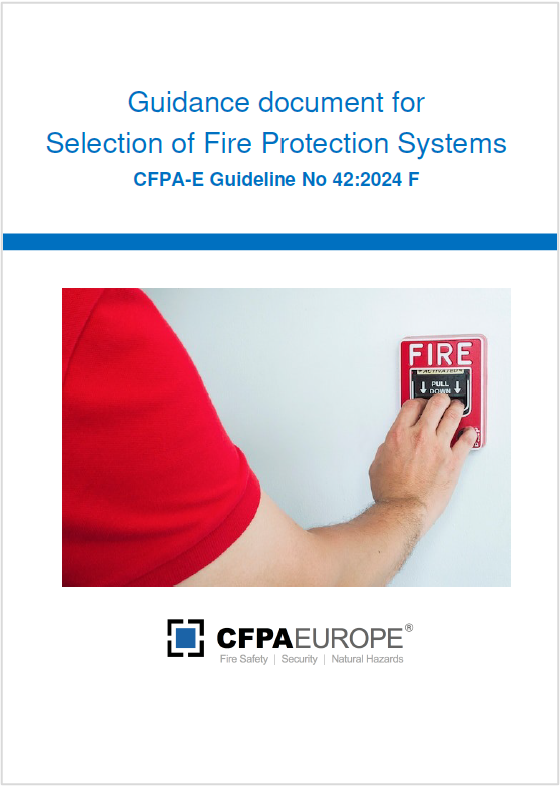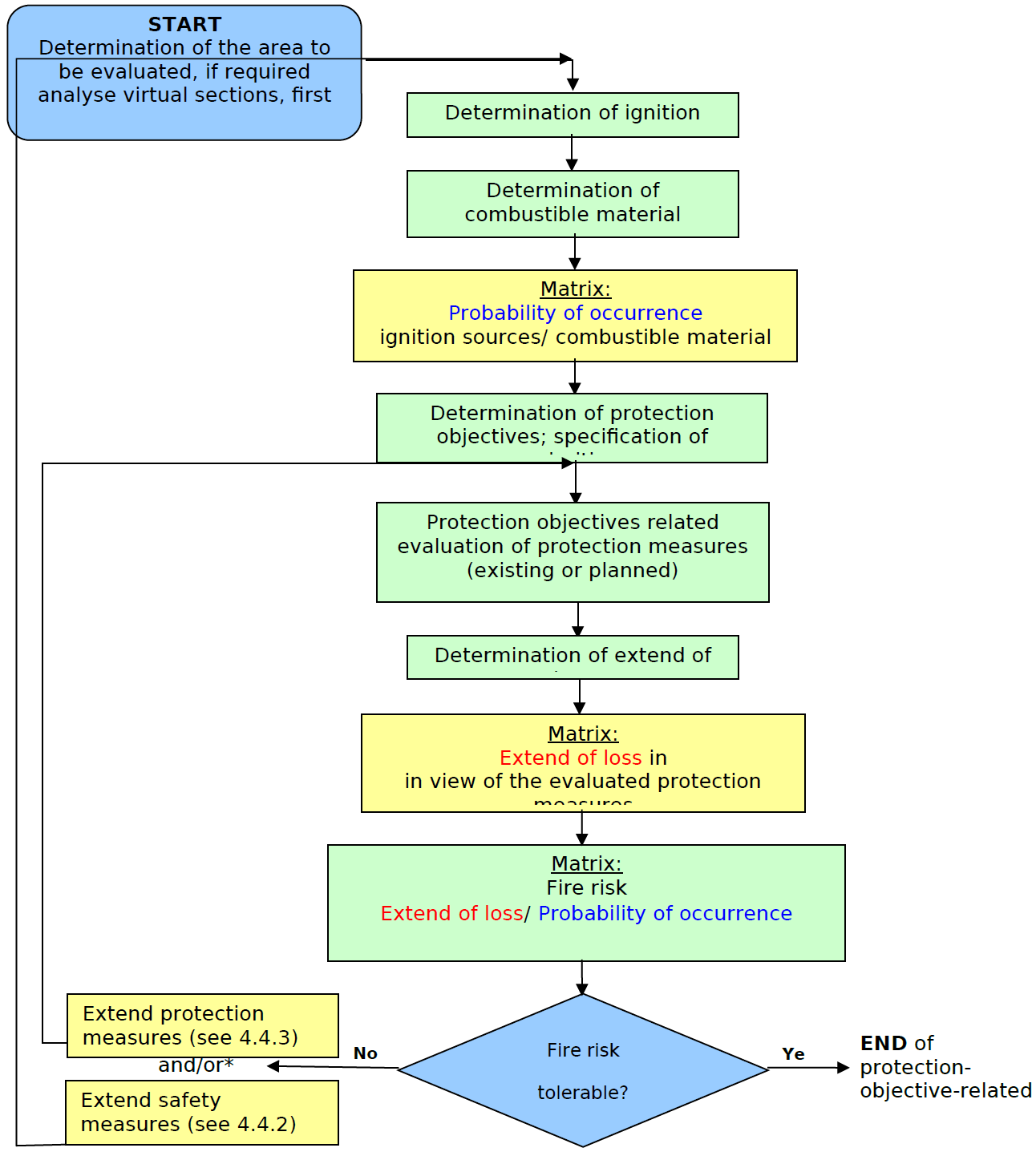Guidance document for Selection of Fire Protection Systems / CFPA 2024
| Appunti Prevenzione Incendi | ||
| 18 Giugno 2025 | ||
| Salve Visitatore | ||
Guidance for Selection of Fire Protection Systems / CFPA 2024 ID 22453 | 22.08.2024 / CFPA-E Guideline No 42:2024 F This guideline presents a general method of choosing protection measures, which are applicable to any risk. When implementing measures for a specific risk, a person shall comply with the corresponding technical guidelines applicable in the particular case. , e.g. fire protection systems. are normally the responsibility of those managing safety in companie. 1 Introduction Laying down protection and safety measures to suit the corresponding risks and with added consideration for economic factors, definitely requires an integral evaluation and decision process. Such a system is based on system-analytic safety methods, which considering risk acceptance and economic factors. Determination of the protective and safety measures requires prior definition of the individual protection objectives. These have to provide for life safety, protection of property, and environmental protection. For the technical protection measures, the existing guidelines for planning and installation should be observed. Selection takes place following the suitability of any selected measure to achieve the protection objective. The use of partial/local protection measures can makes sense, especially if the matrix of ignition source and fire load is definitely not compatible . Also, sufficient separation (distance) of the protected facility from potential fire grounds should be taken into consideration. Structural separation of combinations of combustible material and ignition sources of a particular potential risk may reduce the overall risk for an area. Escape routes shall be provided in all areas where life safety is a factor. These escape routes should not be put at risk by the fire, i.e. neither by heat nor smoke. The escape routes must be able to account for the numbers of people within the area of risk and must ensure that they can all leave the danger area in an adequately short time. Technical fire protection in tall rooms shall allow for correct detection. Be aware, the corresponding fire characteristics which normal detection devices would recognise could be too weak to register when at a ceiling height greater than normal. This guideline presents a general method of choosing protection measures, which are applicable to any risk. When implementing measures for a specific risk, a person shall comply with the corresponding technical guidelines applicable in the particular case, e.g. fire protection systems. are normally the responsibility of those managing safety in companies. But this should also apply to designers, consultants, safety companies etc. so that, in the course of their work, they Should be able to assist companies and organisations to minimize risks and possible fire damages in their businesses. 2 Scope This guideline is applicable to any kind of fire related risk. For any Fire related risk the required and appropriate equipment, policies procedures and precautions can be taken to reduce the risk. That risk could be fire, explosion, smoke or any other where the corresponding rules and regulations apply. [...] 4 Procedure Fire protection systems can reduce damage, providing they work in a reliable and effective manner. They are utilised to reduce the rate of increase of each risk once it has materialised. A proper procedure helps to identify risks in companies and then to mitigate those risks with appropriate protection measures. 4.1 General The risk should be determined for the whole building or enterprise, so as to be able to define the priorities for the safety and protection measures. Further consideration of these measures should also take into account the financial implications, relative to the protection provided by them. Larger areas can be split into zones in which fires starting in one Zone would be unlikely to spread into another neighbouring zone. Zones can therefore be analysed separately, with a number of Zones making up an area or enterprise, with different risks and different safety and protection measures. There are other reasons, why independent analysis of structurally or spatially separated areas is recommended for determining the risk by Zone. Examples of this are: -- Differing risk potentials, such as: Furthermore, any local area protection extinguishing systems may cover large areas, nbut should be considered as a protection system in each Zone that it covers. These Zones should be considered a Fire Compartment, and each should be evaluate individually. In this case, the loss expected according to Table 5-11, would be the worst case to be expected from all evaluations of the area being analysed. The use of virtual sections as a basis for the evaluation requires verification of the actual sections for the effectiveness of their fire protection. Figure 1: Connections in an analysis of the fire risk Taking these connections together, the result is a well-structured means of processing the analysis of a fire risk. This process is shown in the flow chart in Figure 2. Figure 2: Overview of the process of determining fire risk. [...] Contents 1 Introduction 2 Scope 3 Definitions 4 Procedure Annex 1: Probability and extent of loss Annex 2: Protection measures - Basics Annex 3: Example of a fire-risk analysis Annex 4: Example of a PERFORMANCE SPECIFICATION - FIRE DETECTION AND ALARM SYSTEM CFPA Europe CFPA Europe / Organismo riconosciuto DM 3 agosto 2015 G.1.4 Normazione volontaria 5. Norma riconosciuta a livello internazionale: norma adottata da un organismo riconosciuto a livello internazionale. S.5.9 Riferimenti 1. Si indicano i seguenti riferimenti d. European guideline CFPA-E No 1:2014 F “Fire protection management system”. Collegati |
||
 |
||
|
è un sito di INVIO NEWSLETTTER Se vuoi cancellarti dall'invio della newsletter oppure effettua il login al sito ed entra nella Tua Area Riservata, in “Modifica dati” agisci con la spunta sul box di selezione “Newsletter”. L'Elenco completo di tutte le ns newsletter è qui: Archivio newletter |
||
  |
||
| Certifico Srl 2000-2025 | VAT IT02442650541 | ||




































